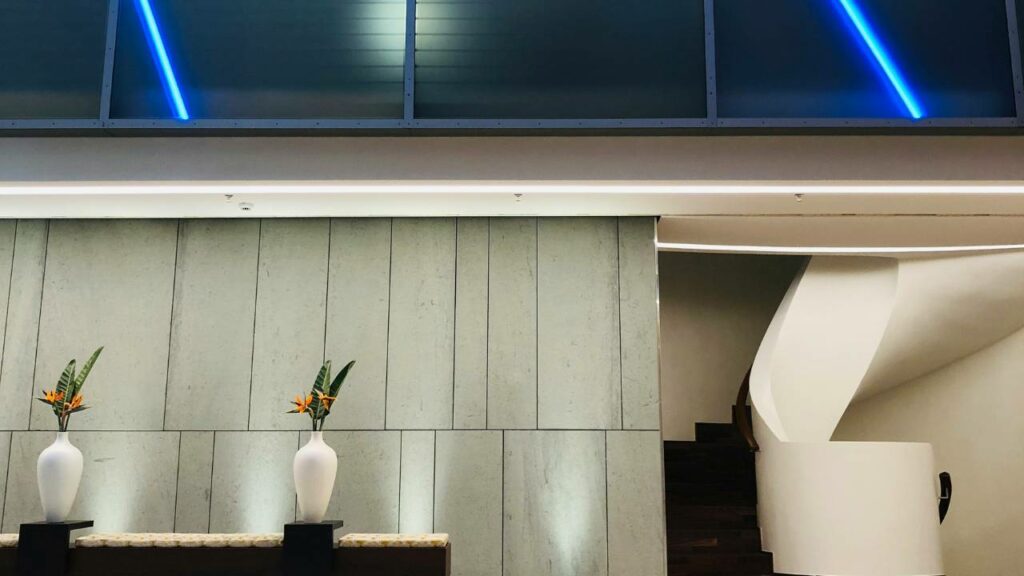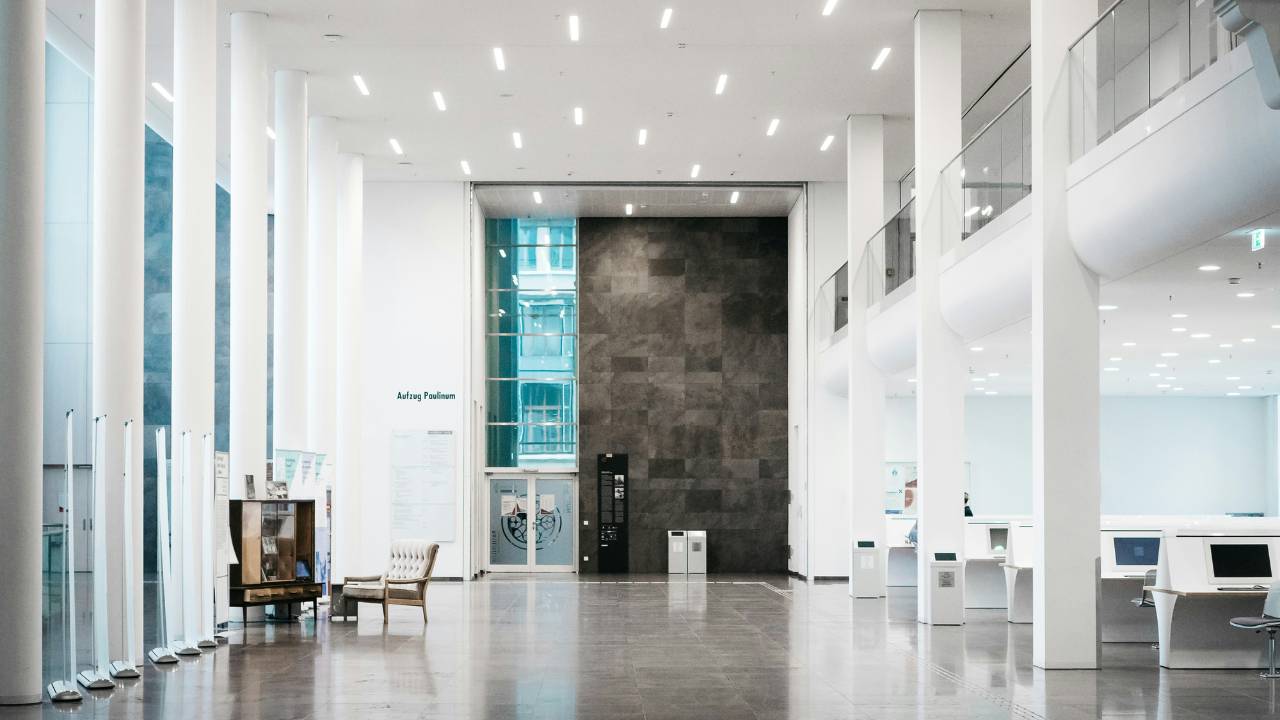Natural stone has long been synonymous with luxury and strength in various design elements, playing a crucial role in the world of business architecture. When you incorporate elements like marble, granite, or slate into your company’s design, you’re not just investing in the aesthetic appeal but also in the timeless value it brings. Each piece of natural stone holds a unique character, ensuring that your business space stands out with an air of exclusivity and sophistication.
Incorporating natural stone into your business design can greatly influence the perception of your brand. As a durable material, it stands as a testament to your business’s commitment to quality and longevity. From sleek marble countertops in a high-end boutique to imposing granite facades on corporate headquarters, natural stone can be a flexible and powerful component in defining a business’s visual and structural identity.
Your choice of stone and its placement can speak volumes about your business values and ethos. It can create an environment that enhances the experience of your clients and employees alike. Whether you’re renovating an old space or constructing a new one, the selection of natural stone can be pivotal to the project’s success, balancing natural beauty with commercial practicality.
Historical Context and Cultural Significance
Natural stone has stood as a witness to the unfolding of human civilisation, integrating deeply into your cultural narratives and architectural accomplishments. Its use in construction and design is not just a choice but a cultural echo that resonates through ages.
Influence on Modern Architecture
Modern architecture often pays homage to the historical use of natural stone, reflecting its durability and aesthetic appeal. For example, the sleek lines of contemporary buildings frequently incorporate stone elements that hark back to ancient times. The Parthenon in Greece is a testament to the timeless allure of natural stone in architecture, its Doric columns and limestone foundations inspiring modern designs.
Tradition and Origin
The tradition of using natural stone is as old as your earliest civilisations. It’s an art that has been passed down through generations, originating from the primal need for shelter and fortification. Cultural monuments across the world stand tall because of this material, each piece telling a story of the culture it embodies. When you gaze upon the Parthenon, you’re actually looking at a piece of Greek culture solidified in stone, a physical narration of human history.
Natural Stone in Contemporary Design

Natural stone has become a centrepiece of modern business design, blending the timeless elegance of materials like marble and granite with cutting-edge architectural techniques. By incorporating these elements, designers create spaces that not only elevate the aesthetic but also contribute to well-being and environmental conservation.
Biophilic Elements in Office Spaces
When you step into an office boasting biophilic design, the presence of natural stone can dramatically transform the atmosphere. It’s been found that including materials like stone in your office can significantly reduce stress and boost productivity. A garden within the business premises or small indoor terrariums can serve as calming focal points, with stone pathways or walls complementing greenery, enhancing your connection with nature.
Sustainability and Eco-Friendly Practices
Incorporating natural stone directly supports sustainability. Being a durable material, it often requires less frequent replacement than others, effectively reducing your carbon footprint over time. Harvested from the earth, each piece of stone retains its unique pattern, allowing you to design a space that’s as eco-friendly as it is stylish. When you’re considering office materials, remember that natural stone’s extensive lifespan and potential for recycling align seamlessly with the ethos of eco-friendly practices.
Technical Aspects and Materials
When you delve into natural stone for business design, understanding the technical facets and material properties will guide your selection for an optimal, long-lasting result.
Properties and Performance of Stone
The intrinsic attributes of natural stone such as strength, durability, and texture can influence its performance in various settings. Marble, with its luxurious finish and decent strength, becomes the centrepiece for many corporate spaces. Limestone, however, offers a softer look with good durability, making it suitable for areas that experience high footfall. Both materials are quarried from Earth, ensuring that each piece has a unique texture, contributing to the bespoke nature of your design.
Selection and Fabrication Processes
Your choice of stone will undergo a fabrication process that transforms raw, quarried rocks into slabs and tiles fitting your design. Midland Stone, for instance, applies meticulous attention to detail during fabrication, respecting the natural qualities of the stone, to ensure the end product can withstand the intended use. From cutting to shaping, the materials you choose are to be prepared with tools and techniques that preserve their natural aesthetic and structural integrity.
Innovative Finishing Techniques
Once stone has been fabricated, finishing techniques are applied to enhance its appearance and suit your business’s aesthetic. Techniques such as honing for a matte finish, polishing for shine and smoothness, or brushing for a textured surface, not only influence the stone’s visual appeal but also affect its maintenance needs. The right finish will accentuate the stone’s natural patterns, without compromising its natural resilience to wear and tear.
Market Dynamics and Professional Insights

In the realm of business design, understanding the fluctuations of the market and leveraging professional insights are crucial. You’ll find that global trends, the expertise of architects and designers, and the refined strategies of the stone trade are tightly interwoven.
Global Trade and Stone Industry
The international stage is abuzz with the vigorous activity of the natural stone industry. Your awareness of global trade is pivotal as it dictates the availability and variety of materials. Sales figures rise and fall with shifts in market share, impacted by factors like foreign exchange rates and international relations. The stone industry marks its pulse at key trade shows such as The International Surface Event (TISE) and Coverings, where you can witness firsthand the dynamism of the sector.
Architect and Designer Perspectives
When you tap into the minds of architects and designers, you uncover a wealth of insights that shape your approach to business design. They advocate for unique and high-quality stone selections, which often set a business apart in a competitive market. Their perspectives influence purchasing decisions and help predict which natural stone products might trend, paving the way for savvy investments. Understanding corporate ethics and sustainability practices also plays a key role when selecting materials.
Business Strategies in Stone Trade
Your business model within the stone trade must be agile, adapting to the ebb and flow of industry demands. By networking at events like TISE and Coverings, you cultivate relationships that could lead to advantageous partnerships or exclusive deals. The strategic placement of your products in these arenas can significantly improve visibility and, subsequently, sales. It’s your ability to anticipate and respond to market needs that will ultimately define your success in the natural stone industry.
Future Trends and Education

In business design, you’ll find that staying abreast of emerging trends and enhancing your professional knowledge are cornerstone practices for success in utilising natural stone. Understanding the power of natural aesthetics in business settings also guides you in crafting unique environments aligned with your brand image. Your continuous professional development directly influences your ability to leverage the visual appeal and textural qualities of natural stone
Emerging Products and Technology
As you look towards the future, innovation in natural stone products is advancing rapidly, keep your eyes open for cutting-edge materials on the horizon. The Natural Stone Institute often leads the charge, consistently offering new findings and technological advancements. Expect to see novel applications and product designs that aim to meet and exceed ISO standards for quality and sustainability.
New products are frequently under development, with a focus on improved durability and aesthetic variety. The integration of technology with natural stone allows for smarter resource management and opens up avenues for customisation that were previously unattainable.
Professional Development and Resources
Your continuous professional development in the business design realm directly influences your ability to craft compelling spaces with natural stone. Numerous associations provide educational materials, certification programs, and endless learning resources. They guide you on the best practices for incorporating stone into your designs.
Stay connected with the likes of the Natural Stone Institute to learn about the latest standards and design methods. They also offer a range of certifications that could enhance your credentials and demonstrate your commitment to excellence in natural stone design.
Practical Guidance for Implementation
When introducing natural stone into your business design, consider a few key steps to ensure a successful installation. It’s important to work closely with the design community as you choose the right stone that resonates with your brand image.
Begin by selecting a stone based on your desired aesthetic and functional needs. Reach out to salespeople who are knowledgeable in natural stone varieties as they can offer valuable advice and product options. Ensure that the stone you select is appropriate for your space in terms of durability and maintenance.
Installation should be carried out by professional technicians who can guarantee precise and secure fitting of the stone. It is critical to follow best practices for installation to avoid future issues and preserve the stone’s inherent beauty.
For maintenance, establish a simple yet effective routine. Natural stone might require periodic sealing and cleaning with the correct products, and this upkeep is pivotal to sustain its condition and appearance. Always consult with your provider for specific care advice tailored to your chosen stone.
Engaging with the design community not only inspires creative use of stone but can also enhance your network, potentially leading to partnerships or collaborations.
Finally, having natural stone in your business environment can positively impact productivity. Stone accents are known to create inviting and professional atmospheres, thus improving the overall mood of the space. Remember, this entails an environment where your employees and customers feel comfortable, which often translates to increased efficiency and satisfaction.
Conclusion
Incorporating natural stone into your business design invites nature indoors, offering a serene and grounding effect. Whether you select marble, granite, or limestone, the material’s natural variations ensure that your space is truly one-of-a-kind.
Remember, your space speaks volumes about your brand, and by crafting corporate ambiance with natural stone, that conversation is always sophisticated and grounded in quality.
